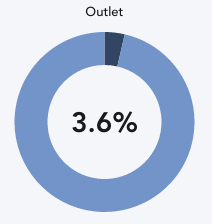Market: What Are The Definitions Of Status Terminology?
New in: the date EDITED first saw the product. Occasionally, this may not match the retailer's view of when the product was new in, for example, if the product was not added to the site immediately, or if the product was added after the last time the site was tracked. You'll see this term used within the control panel (Price & Status filter), Products (Timeline) and Analysis (Statistics & History).

Last Seen: The date when the product was last seen on the retailer's website. You'll see this term used within Products (Timeline)

Merchandising Information History: Information that the retailer has provided about how the product is merchandised e.g. online only.

Outlet: The product is marketed as outlet by the retailer. You'll see this term used within the control panel (Price & Status filter) and Analysis (Statistics tab). Outlet products are indicated by an icon that says Outlet.

Outlet %: The percentage of products that have outlet status in your workbook. You'll see this term used in Analysis (Statistics tab).

Secondhand Retailers: Products sold by second-hand retailers. These are a specific set of retailers that sell products in the second-hand market.

Non-transactional Sites: Some retailers don’t have transactional e-commerce sites (sites where you can complete a purchase) but we’re still able to track some of their data in EDITED.The way we track these sites works a bit differently to the traditional e-commerce sites that you’re used to seeing in EDITED.For non-transactional sites we may not be able to collect any SKU or availability information. We can only collect the information that is presented on the site, which may contain the product ID, name, gender, color and price. If a site is non-transactional, we'll declare it in the retailer's name.
